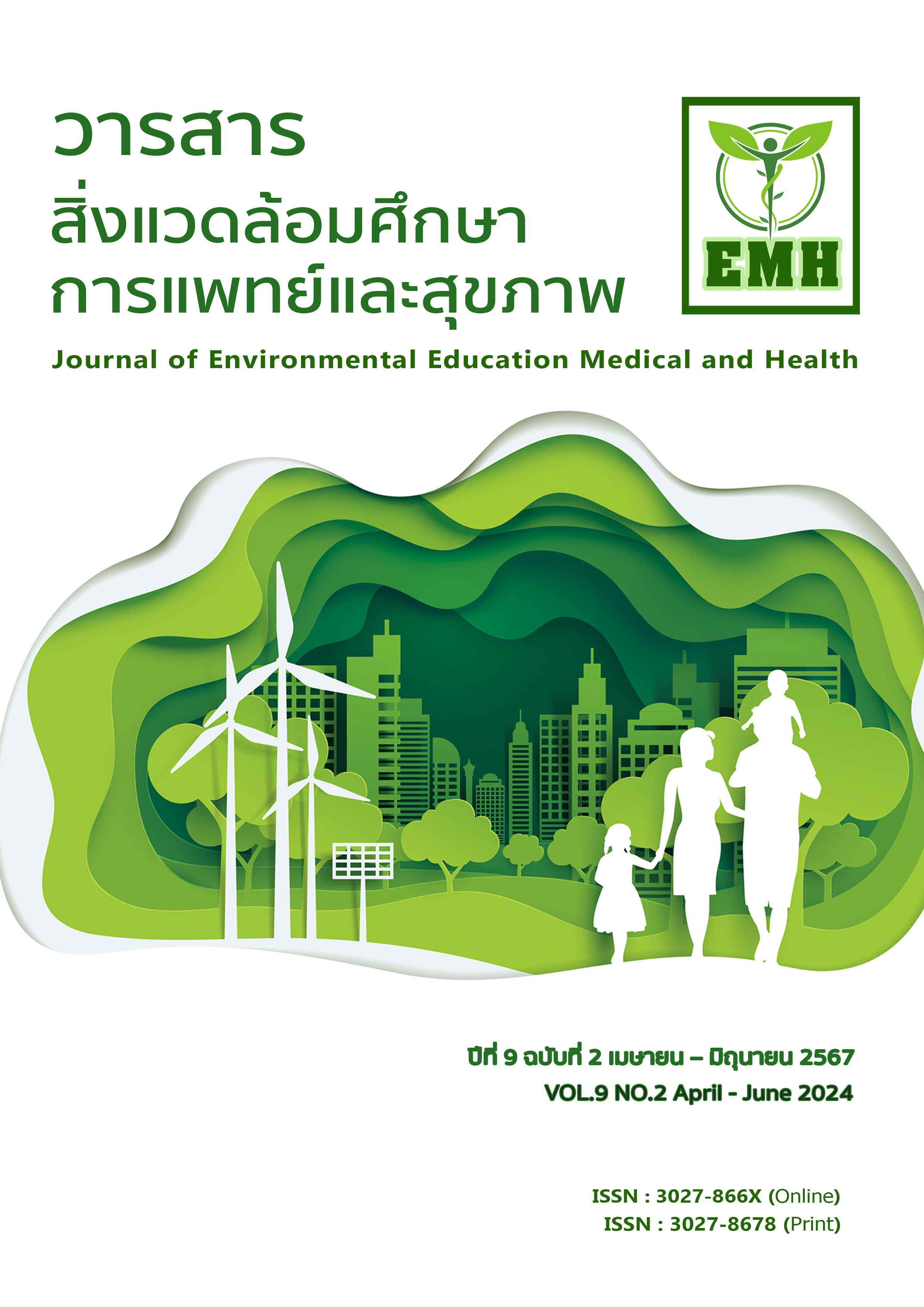ประสิทธิภาพการตรวจติดตามความเค็มในอาหารด้วยเครื่องวัดเค็มในผู้ป่วยสูงอายุ ที่เป็นโรคความดันโลหิตสูงที่ไม่สามารถควบคุมได้ในตำบลร่อนพิบูลย์
คำสำคัญ:
เครื่องวัดเค็ม, ความดันโลหิตสูง, ความไวต่อการรับรสเค็มบทคัดย่อ
งานวิจัยนี้มีวัตถุประสงค์เพื่อศึกษาประสิทธิภาพของการใช้เครื่องวัดเค็มและการให้ความรู้เกี่ยวกับอาหารที่มีเกลือสูงในผู้สูงอายุที่ป่วยเป็นโรคความดันโลหิตสูงที่คุมไม่ได้ (ค่าเฉลี่ย systolic blood pressure (SBP) ≥140 มิลลิเมตรปรอท และค่าเฉลี่ย diastolic blood pressure (DBP) ≥90 มิลลิเมตรปรอท) งานวิจัยนี้เป็นการศึกษาแบบสุ่มที่มีกลุ่มเปรียบเทียบโดยสุ่มเลือกผู้สูงอายุตั้งแต่ 60 ปีขึ้นไป เข้าร่วมโปรแกรมโดยการใช้เครื่องวัดเค็มในอาหารก่อนรับประทานและการให้ความรู้ (กลุ่มทดลอง) และให้ความรู้เพียงอย่างเดียว (กลุ่มควบคุม) และทดสอบความไวต่อการรับรสเค็ม เป็นเวลา 6 สัปดาห์
ผลการศึกษาพบว่าผู้ป่วยที่เข้าร่วมทั้งหมด จำนวน 114 ราย แบ่งออกเป็นกลุ่มทดลอง จำนวน 57 ราย และกลุ่มควบคุม จำนวน 57 ราย มีอายุเฉลี่ย 73.56±9.10 และ 74.73±9.01 ปี ตามลำดับ พบว่าหลังจากสัปดาห์ที่ 6 กลุ่มทดลองมีการเปลี่ยนแปลงค่า SBP และ DBP อย่างมีนัยสำคัญ (P < 0.05) โดยมีค่าเฉลี่ย SBP เท่ากับ 137.01±8.98 มิลลิเมตรปรอท (ลดลง 8.81) และค่าเฉลี่ย DBP เท่ากับ 94.19±3.17 มิลลิเมตรปรอท (ลดลง 13.12) ตามลำดับ นอกจากนี้ กลุ่มทดลองมีการปรับเปลี่ยนความไวต่อการรับรสเค็มที่ความเข้มข้นเกลือต่ำลงอย่างมีนัยสำคัญเมื่อเทียบกับกลุ่มควบคุม (P <0.001) โดยมีค่าเฉลี่ยเท่ากับ 23.78±13.14 มิลลิโมลต่อลิตร (ลดลง 4.99)
เอกสารอ้างอิง
Lewington S, Clarke R, Qizilbash N, Peto R, Collins R, Prospective Studies C. Age-specific relevance of usual blood pressure to vascular mortality: a meta-analysis of individual data for one million adults in 61 prospective studies. Lancet. 2002;360(9349):1903-13.
Rusmevichientong P, Morales C, Castorena G, Sapbamrer R, Seesen M, Siviroj P. Dietary Salt-Related Determinants of Hypertension in Rural Northern Thailand. Int J Environ Res Public Health. 2021;18(2).
Chailimpamontree W, Kantachuvesiri S, Aekplakorn W, Lappichetpaiboon R, Sripaiboonkij Thokanit N, Vathesatogkit P, et al. Estimated dietary sodium intake in Thailand: A nationwide population survey with 24-hour urine collections. J Clin Hypertens (Greenwich). 2021;23(4):744-54.
กระทรวงสาธารณสุข. ยุทธศาสตร์การลดการบริโภคเกลือและโซเดียมในประเทศไทย พ.ศ. 2559-2568. กระทรวงสาธารณสุข. 2559.
Oner C, Dilan Turan R, Telatar B, Yesildag S, Hergun S, Elmacioglu F. A pilot study on salt taste sensitivity threshold in Turkish young adults. Anatol J Cardiol. 2016;16(9):731-2.
Piovesana Pde M, Sampaio Kde L, Gallani MC. Association between Taste Sensitivity and Self-Reported and Objective Measures of Salt Intake among Hypertensive and Normotensive Individuals. ISRN Nutr. 2013;2013:301213.
Suwanna K, Sittibun W, Kaewdam J, Innupaph L, Homprasit J, Dumthong S, et al. Effect of Reducing Salt Consumption Program towards Dietary Consumption Behavior among with Hypertensive Risk Group: A Case study in Nakhon Si Thammarat (in Thai). Health Science Journal of Thailand. 2021;3(2 ).
Thangkratok P, Chookok S, Mongkoldee P, Pinrot P, Puangpetch P. Salty eating behavior of aging in Bang-Plad District, Bangkok. KKU Journal for Public Health Research. 2016;9(3-4):72-8.
Suntep W. The Effectiveness of Using the Nutrition Symbols: Healthierlogo Program in the Consumer Group Wiang Nuea Subdistrict, Mueang District, Lampang Province (in Thai). Journal of Health Sciences Scholarship. 2021;8(1):185-206.
Wiriyatanakorn S, Mukdadilok A, Kantachuvesiri S, Mekhora C, Yingchoncharoen T. Impact of self-monitoring of salt intake by salt meter in hypertensive patients: A randomized controlled trial (SMAL-SALT). J Clin Hypertens (Greenwich). 2021;23(10):1852-61.
กลุ่มงานเวชระเบียน. รายงานเวชระเบียน โรงพยาบาลร่อนพิบูลย์ ประจำปีงบประมาณ 2566. โรงพยาบาลร่อนพิบูลย์. 2566.
Yamane T. Statistics: An Introductory Analysis, 2nd ed. Harper and Row: New York, NY, USA. 1967.
Khokhar D, Nowson CA, Margerison C, Bolam B, Grimes CA. Knowledge and Attitudes Are Related to Selected Salt-Specific Behaviours among Australian Parents. Nutrients. 2018;10(6).
Li N, Yan LL, Niu W, Yao C, Feng X, Zhang J, et al. The Effects of a Community-Based Sodium Reduction Program in Rural China - A Cluster-Randomized Trial. PLoS One. 2016;11(12):e0166620.
Halpern BP. What's in a name? Are MSG and umami the same? Chem Senses. 2002;27(9):845-6.
Lee J, Hwang Y, Kim KN, Ahn C, Sung HK, Ko KP, et al. Associations of urinary sodium levels with overweight and central obesity in a population with a sodium intake. BMC Nutr. 2018;4:47.
Balafa O, Kalaitzidis RG. Salt sensitivity and hypertension. J Hum Hypertens. 2021;35(3):184-92.
WHO. Noncommunicable diseases country profiles 2018. Geneva: World Health Organization, 2018. 2018.
Greer RC, Marklund M, Anderson CAM, Cobb LK, Dalcin AT, Henry M, et al. Potassium-Enriched Salt Substitutes as a Means to Lower Blood Pressure: Benefits and Risks. Hypertension. 2020;75(2):266-74.
Kirsten VR, Wagner MB. Salt taste sensitivity thresholds in adolescents: are there any relationships with body composition and blood pressure levels? Appetite. 2014;81:89-92.
Wise PM, Breslin PA. Individual differences in sour and salt sensitivity: detection and quality recognition thresholds for citric acid and sodium chloride. Chem Senses. 2013;38(4):333-42.
Kusaba T, Mori Y, Masami O, Hiroko N, Adachi T, Sugishita C, et al. Sodium restriction improves the gustatory threshold for salty taste in patients with chronic kidney disease. Kidney Int. 2009;76(6):638-43.
He FJ, Tan M, Ma Y, MacGregor GA. Salt Reduction to Prevent Hypertension and Cardiovascular Disease: JACC State-of-the-Art Review. J Am Coll Cardiol. 2020;75(6):632-47.
Jin A, Xie W, Wu Y. Effect of salt reduction interventions in lowering blood pressure in Chinese populations: a systematic review and meta-analysis of randomised controlled trials. BMJ Open. 2020;10(2):e032941.





